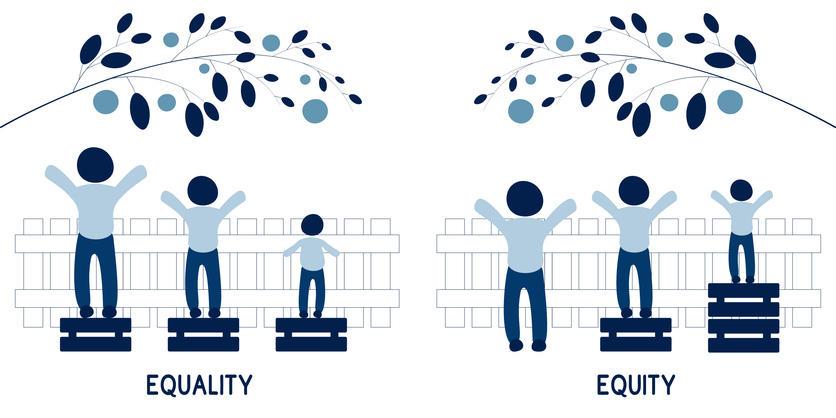Equity in the workplace: What is the “E” in DEI?

We often discuss “DEI” and how important it is to include DEI efforts in your workplace. Diversity and inclusion (the “D” and “I,” respectively) are often discussed, but newer and sometimes less often emphasized is the “E”—equity.
What is equity in the workplace? How does it differ from equality? And why is it so vital to define systems and processes that give each team member not just the same treatment, but equitable treatment? We’re unpacking all these questions to help you create stronger teams, better employee retention, and more beneficial working environments.
What is equity in the workplace?
Equity is fairness: the fair treatment of all people in the workplace, including access to resources, advancement opportunities, salary standards, and more.
True equity considers all the historical, societal, and political factors that privilege opportunity to certain demographics, while working to combat the inherent disadvantages that other demographics face. An equitable workplace defines systems and procedures that promote fair decision-making to meet the individual needs of each team member.1
Equity vs equality at work: what’s the difference?
Although often used interchangeably, equity and equality are not the same. While equality implies equal treatment of all people, equity more intentionally distributes resources to meet team members’ needs based on their very wide range of different circumstances.
EquityActively assign resources based on employees’ individual needs | EqualityTreat everyone the same |
For example, an internal promotion position may open on your team. As a decision-maker, you may give everyone on that team an equal opportunity to apply and be judged by their merits. This is equality, because everyone is treated the same and given an equal chance to apply for the promotion.
However, perhaps your team is comprised of a very diverse group of people: some have more experience than others, but discriminatory systems afforded them an advantage in earning these credentials where others were not given the opportunity. This means that your team members aren’t really starting on an even playing field, so treating them exactly equally is a very narrow perspective.
Equity, on the other hand, considers the wider context of each employee’s situation. An equitable approach may provide extra training to raise up candidates who show leadership potential or to grant opportunities based on current skills demonstrated, rather than previous experience gained.1
Examples of equity in the workplace
Equity in action may take many different forms, just as your team members have many different needs. Some examples of equity in the workplace include:
Accommodate diverse abilities and health conditions
This may include things like updating the infrastructure, furnishings, and equipment in your office to accommodate people with disabilities.
Offer flexible hours and working schedules
Understand that family and personal life is important for your employees. Certain tasks and meetings may need to be held during specific hours, but you can allow other tasks to be dome flexibly, at the times when your team members are best able to complete them.
Provide team training and advancement opportunities
Equip your team members with the training they need to succeed in high-level positions and advanced responsibilities, and support their initiatives in seeking further learning.
Hire for skillsets, rather than degrees
Not everyone has been afforded the same opportunities for education. Look at the skillsets your potential higher can bring to the table, rather than the institutions where they received their degrees.
Provide equipment, software, and tools for employees to do their best work2
From computers to software to hardware that accommodates individual needs, make sure that each team member has what he/she needs to succeed.
Prioritize equitable, transparent wages
Talking about salaries has a history of being taboo, but it’s good to normalize transparency is wages so that everyone is held accountable. Likewise, award bonuses and incentives based on results well-done, rather than titles and positions.
Represent diversity at all levels3
Our social systems privilege education and experience to certain demographics over others. Prioritize making your teams diverse at all levels, including leadership positions.
Challenges to achieving equity in the workplace
There are many challenges that organizations must overcome to truly implement equity in the workplace.
Systemic inequality
First and foremost, our society is embedded unfair systems, which provide certain demographics with opportunities that others are not given. We may often think that we’re being equitable by hiring based on merits like experience and education, without considering the inequity that our society privileges select demographics in these areas, and the challenges that other demographics face just to reach that same starting point.
Subjective perspectives
What is “fair” is up to individual interpretation. Where one employee may feel that there is equity in the workplace, another may look at the same set of circumstances and feel under-supported and under-represented. This can cause confusion as to how best to allocate resources.
Lack of communication
A lack of transparency and open conversations can lead to blind spots and inequities that go unnoticed. Organizations may even have the intention of promoting equity, but don’t actively promote an environment where feedback is encouraged.
Individual ego and biases
Leadership ego is the last thing that promotes equity in the workplace. When one or a few individuals aren’t receptive to new ideas and people joining the leadership team, or aren’t willing to change the exclusive systems we’ve been using in the corporate world for decades, then power stays within a small demographic and equitable changes cannot be implemented.4
Valuing the business over the people
Prioritizing business over people inhibits equitable decisions. When organizations don’t realize that their teams are their most important assets, they will allocate resources towards their operations, rather than investing in their employees’ needs.
How to support equity in the workplace
As a team leader, you can help support and apply equity at your workplace. Here are 5 steps to get you started:
- Include equity as one of your organization’s fundamental values.
- Get to know your people and value their individual needs, skills, and experiences.
- Understand that policies may look different in application.
- Promote conversations around equity and seek feedback from your teams.
- Earn your DEBI CPE Certificate with Becker!
Becker’s DEBI CPE Certificate equips you with the knowledge and skills to implement more equitable systems in your workplace and make a positive impact.
- https://www.gallup.com/workplace/401573/workplace-equity-dei-why-matters.aspx
- https://insightglobal.com/blog/equity-in-workplace/
- https://www.instride.com/insights/examples-equity-in-the-workplace/
- https://www.forbes.com/sites/aparnarae/2023/08/03/unraveling-four-common-roadblocks-to-workplace-equity-and-inclusion-a-conversation-with-dr-pierce-otlhogile-gordon/










